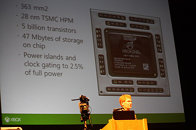Monday, November 3rd 2014

AMD to Give 20 nm Optical Shrinks to Console SoCs First
AMD has the unique distinction of supplying SoCs to all three leading game console vendors simultaneously - Microsoft, Sony, and Nintendo. The company, like NVIDIA, is looking forward with perched eyes for manufacturing partner TSMC to get its 20 nanometer silicon fabrication node running full-cylinders. Unlike NVIDIA, which may use the new process to shrink its GPUs, or launch bigger chips based on its "Maxwell" architecture, AMD will treat its console SoCs with optical-shrinks to the new nodes first, so the company could immediately eke out better margins, as console gamers upgrade to Xbox One or the PlayStation 4.
AMD's SoC for the Xbox One, could be the first in line for this optical shrink to 20 nm. This chip features a transistor count of 5 billion, and houses eight 64-bit x86 CPU cores, and a 768 SP GPU based on the Graphics CoreNext architecture; 48 MB of on-die cache, and a quad-channel DDR3 IMC. The chip also features an integrated core logic. AMD's chip for the PlayStation 4 features design inputs from Sony. The chip features the same CPU component, but a 1152 SP GPU, and a 256-bit wide GDDR5 memory interface, wired to 8 GB of memory that's virtualized for both system- and graphics-memory. The 20 nm shrinks of both chips are expected to lower not just manufacturing costs, but also step up energy-efficiency, which could then let Microsoft and Sony save additional costs on other components, such as power and cooling.
Source:
Expreview
AMD's SoC for the Xbox One, could be the first in line for this optical shrink to 20 nm. This chip features a transistor count of 5 billion, and houses eight 64-bit x86 CPU cores, and a 768 SP GPU based on the Graphics CoreNext architecture; 48 MB of on-die cache, and a quad-channel DDR3 IMC. The chip also features an integrated core logic. AMD's chip for the PlayStation 4 features design inputs from Sony. The chip features the same CPU component, but a 1152 SP GPU, and a 256-bit wide GDDR5 memory interface, wired to 8 GB of memory that's virtualized for both system- and graphics-memory. The 20 nm shrinks of both chips are expected to lower not just manufacturing costs, but also step up energy-efficiency, which could then let Microsoft and Sony save additional costs on other components, such as power and cooling.

44 Comments on AMD to Give 20 nm Optical Shrinks to Console SoCs First
Cable boxes, who wouldn't want a 15W AMD dual core with hardware acceleration and upscaling with frame interpolation for 60Hz with a bit of extra tech?
How about a Samsung Windows tablet with X64 and 8GB of RAM, if my phone can fit 2GB there is no reason I can't have a tablet that does 1080 without stuttering (looking at you Surface, they tried to give me at work!!!).
Think of all the companies who make anything with a screen. Basic color displays replaced by a cheap 16bit depth all in one. Midrange printers with shitty slow displays make me want to go Office Space on them. If AMD took a old GPU and shrunk it and ran off some on the edge of the wasted wafer space and sold them for a few bucks each to companies.....
But surely they didn't tried to make gazillions, with those chips. They wanted to change the way games are made. Games where made with Intel+Nvidia hardware in mind and just checked for compatibility issues on AMD hardware. The results? We know the results. Everyone blaming AMD hardware and drivers, waiting for the next patch or two. Well, I don't hear much negative comments lately. Games are programmed with AMD hardware in mind today(OK, maybe this isn't the case for Ubisoft) and in the (near) future. Many, not fast, cores and GCN architecture. AMD wins even if they make pennies from each APU. Even if the savings from the 20nm shrink goes to SONY's and Microsoft's pockets, AMD still wins. And of course, there is Mantle.
People with the old console get to run the new games, just that its capped at 30FPS where the revision gets 60.
they dont like it? upgrade! all their games, controllers etc all still work...
I would rather buy a new GPU in all seriousness.
But with the latest consoles being PCs, it will be easy for MS and SONY to close the gap between generations. I don't expect PS5 or Xbox Two is 8 years, but maybe in 3 or 4, with today's models to be able to play many of the games for the next generation with lower quality settings.
make it so a new console plays the next gen games as well as previous ones, but the previous ones run better.
MUSSELS DEMANDS BACKWARDS COMPATIBILITY.
Each year the PC games looked better and better and the gfx on console games started to look shabby as the years progressed.